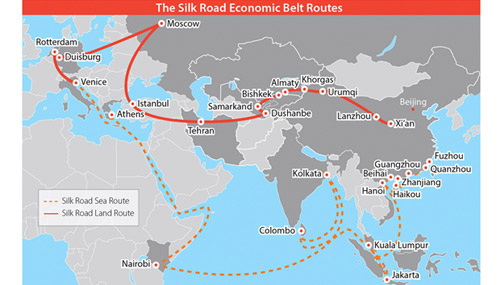US-Asia Business
New Opportunities in China’s “One Belt One Road” Initiative
By Daniel Allen

How can Western firms benefit from the most ambitious infrastructure plan in the world?
Rich in resources and a strategic trade conduit between East and West, Central Asia is no stranger to the machinations of world powers. The myriad trails of the Silk Road once spanned this complex region, while centuries later Russia and Britain battled for political supremacy here in the so-called "Great Game." Today, China is seeking to develop this vast hinterland.
After years of whirlwind economic development, Beijing is now looking beyond China's borders for opportunities to invest, trade and secure vital energy supplies, not to mention bolster the country's international standing. To this effect, the so-called "One Belt, One Road" (OBOR) initiative - first introduced as a concept by Chinese President Xi Jinping in late 2013 - is the Politburo's grand plan to connect the countries in this vast region.
OBOR is nothing if not ambitious. Taken together, the terrestrial "Belt" - which largely covers Central Asia - and the (somewhat confusingly named) maritime "Road" route will stretch all the way from Eastern Europe to Indonesia. Involving new roads and rail lines, ports and pipelines, Beijing's aim is to boost connectivity and commerce across the region, with China as the hub. Encompassing more than 60 countries with a total population of more than 4 billion people, the obstacles, costs and potential rewards are massive.

Economic imperatives
Since OBOR was first announced two years ago, China has spared no effort or expense laying the groundwork. It has poured money into the new Asian Infrastructure Investment Bank (AIIB), the Silk Road Fund and the Shanghai Cooperation Organization (SCO), and has inked trade and investment deals with numerous countries along the initiative's twin trade routes.
For now, at least, cheap loans and infrastructure projects are the backbone of OBOR. According to research by London-based investment bank Grison's Peak, the lion's share of loans by Beijing’s principal policy lenders - the China Development Bank and the China Export-Import Bank - have been to OBOR countries since the initiative was unveiled. In the third quarter of 2015, 17 out of 19 government loans were to projects and countries along OBOR routes, representing 90 percent of China’s overseas lending during the period.
With China's economy slowing and attempting to move up the value chain, the country is now suffering from a huge overcapacity in industries such as steel and heavy equipment. Beijing sees OBOR's infrastructure projects as a convenient way of soaking up the surplus.
"The drivers for OBOR are multiple," says Michal Meidan, founder and director of consultancy China Matters and an associate fellow at London-based think tank Chatham House. "Firstly, China needs to export its overcapacity in heavy industry. Secondly, investing in infrastucture links in Asia and Eurasia potentially offers better returns on China’s large foreign exchange reserves than T-bills from the United States. Thirdly, OBOR acts as a counter to the U.S.-led Trans-Pacific Partnership, placing China at the heart of Asian and Eurasian economic integration," Meidan said.
International response
The global response to OBOR has been guardedly positive. With more than 50 countries joining the AIIB, one of the main financial platforms for facilitating OBOR, there is much enthusiasm among Western and non-Western countries for the initiative and the opportunities it may create.
Chinese companies have already experienced success operating in foreign markets (such as Ethiopia) where Western competition is largely absent. Yet their experience in Libya, from where over 35,000 Chinese workers had to be evacuated in 2011 during the Libyan civil war, has also taught them to be more cautious.
"Chinese firms and financiers have a relatively good track record in building rail, energy and communications infrastructure around the world," says Michal Meidan. "Where they have often fallen short overseas is in their analysis of risk."
Yet OBOR is not only about banks and finance, but also about geopolitics. The huge disparity in the economics and politics of countries along its routes means that China will face a huge challenge in persuading many to get behind its master plan.
"A lot of countries are suspicious of Chinese intentions," says Merlin Linehan, a former financial analyst who consults on trade and investment in emerging markets as well as China’s "go global strategy" through his China in Africa consultancy and Frontier Markets website.
Risks and rewards
The bulk of financing for OBOR is and will continue to be Chinese for the foreseeable future. This, coupled with China's comparative advantage in large-scale construction, will see Chinese enterprises take the lead on most of the initiative's large-scale infrastructure projects. Yet there will be opportunities for Western construction and logistics firms, especially in economically depressed areas, such as Central Asia and Eastern Europe.
"Much of what initially needs to be done is basic railway track laying and road building," says Chris Devonshire-Ellis, founding partner of Asia-based professional services firms Dezan Shira & Associates and author of a new book entitled "China's Economic Silk Road".
"The Chinese can do that at far lower costs than the West. The major benefits will come further downstream in terms of associated technologies rather than at the front end. OBOR will take 30 to 40 years to come to fruition."
If the Chinese press ahead with their plan to develop a cohesive economic area, it will generate a growing amount of business for well-placed multinationals across many industrial sectors.
"As the implementation of OBOR, and challenges related to it, become clearer, there will certainly be new opportunities for Western firms to engage with Chinese partners seeking to mitigate local risk," says Meidan, "Companies and investors that have a strong foothold in some of the OBOR countries and that have a long and positive track record of operating there can become powerful partners to Chinese investors."
As OBOR develops, markets along its routes will open up and diversify. Barriers to trade will come down and business environments will become more conducive to overseas investment. Western firms offering consulting, management and other professional services will see demand for their services increase, while industrial sectors such as telecommunications, finance and energy will all require Western technology and expertise.
On the flip side, working with many Chinese companies is likely to remain a challenge. In many of China's companies, especially state-owned enterprises, decision-making structures and incentives remain opaque. Competition with Chinese firms in many areas will be stiff, as they can often operate in riskier environments at lower costs.
It is the Chinese government's stated aim to generate an additional US$2.5 trillion in trade with OBOR countries over the course of the next decade. With a more developed OBOR region creating a bigger economic pie for everyone, the economic incentives for Western firms to get involved are clear. As the initiative moves from rhetoric to reality, such firms will need to position themselves well to win business in a range of demanding markets.
"Right now, Western companies should be lobbying their governments to engage in OBOR through related institutions and mechanisms," says Dragan Pavlićević, contributing analyst at Wikistrat, a geostrategic consultancy company.
"Synchronisation and synergy between development policies and financing platforms will allow them to benefit far more from the initiative."
Sign up for the Reach Further Newsletter
We’ll keep you in the know about the latest US-Asia business news and trends.
Suscríbase al boletín Reach Further
Lo mantendremos informado sobre las últimas noticias y tendencias comerciales entre Estados Unidos y China.

